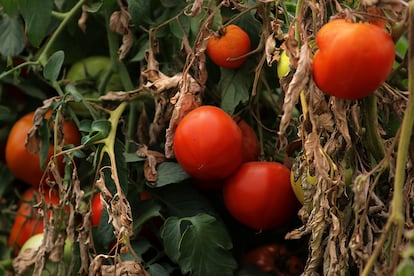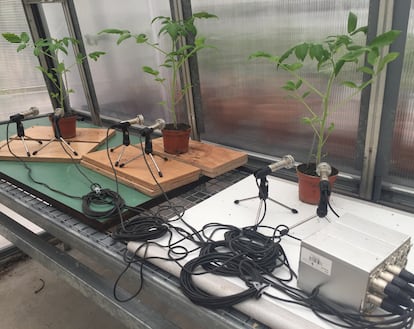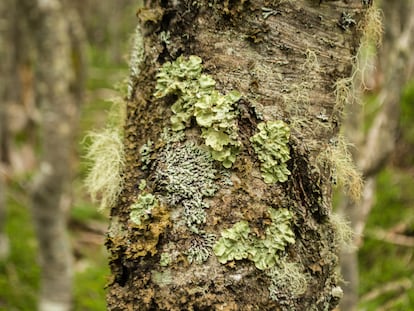Plants make sounds when they are stressed
Lack of water, cut stems or infections generate certain noises due to the movement of fluids. However, this is not a form of communication, experts point out

When plants are stressed, they sound like popcorn. Imagine bubble wrap being popped. That is what a team of Israeli scientists found after performing a series of experiments; not only that, but their sound profile varies, depending on their plight – whether they need water, have a stem cut or are infected by a virus. The researchers were also able to distinguish between the sound waves of a tomato plant, of tobacco and a cactus. So, does this mean that plants actually speak? Are they trying to communicate? No. The explanation is much simpler and it has to do with basic physics.
Plants respond to changes in the environment, especially if they cause them stress. They lose their greenness, their leaves droop and they wither. Recent research has also shown that they can communicate chemically, by releasing volatile substances when attacked by insects. In 2019, a team led by the biologist and mathematician Lilach Hadany from the Tel Aviv University, in Israel, also found that flowers increased their nectar sugar concentration a few minutes after hearing the buzz of pollinators. Now, Hadany and her colleagues have discovered that they also make sounds that contain information.
The experiments began in a soundproof room where they placed dozens of tomato and tobacco plants. Because they had never been heard before, they assumed that if they made sounds, they must be in parts of the spectrum that humans cannot perceive; with this in mind, they put the subjects of study near ultrasound microphones, capable of recording sound waves with a frequency between 20 and 250 kilohertz (an adult human rarely hears beyond 16 kHz). Some of them were left without water for five days and others had some stems cut off. For comparison, they also left some alone.
"Any system of pipes that transports a fluid generates sounds and that does not mean that a water pipe is trying to communicate with anyone"Carlos Vicient, Centro de Investigación en Agrigenómica
The results, published in the scientific journal Cell, show that the unstressed plants emitted on average one sound per hour, while the dry ones increased their noise to 35 per hour in the case of tomato plants and 11 per hour in that of tobacco. In those that were cut, the sounds were 25 and 15 per hour, respectively. One notable detail is that the tomato plants increased the number of sounds as the days without water passed; but then, when dehydration threatened their lives, they slowed down until they stopped emitting them altogether. With these first data, the researchers designed an algorithm and repeated the experiments in a greenhouse, a more realistic environment. Their artificial intelligence was able to detect which ones were making sounds, how many and what type of stressor was causing them.
“In this study we solve a very old scientific controversy: we prove that plants emit sounds,” says Hadany. “Our findings suggest that the world around us is full of plant sounds and that they contain information, for example, about water scarcity or about injuries. We assume that the sounds emitted in nature are detected by nearby creatures, such as bats, rodents, various insects and possibly other plants as well.”

The phenomenon is not limited to tomato and tobacco. The researchers repeated their experiments with corn, wheat, nettles and cacti, and they all made sounds. In addition, they found that they also emitted them when they were infected with the tobacco mosaic virus, a pest of Solanaceae plants. Some of the ultrasound waves were picked up by microphones up to 16 feet away. The Israeli scientists also saw that in the woodiest plants, such as the almond tree or the grapevine, the sound was practically imperceptible.
The authors of the study are not sure about the reason behind this. The bark might be interfering, or perhaps they emit sounds at other frequencies, speculates Hadany, acknowledging the need to study the matter further. They are also not entirely clear on how these sounds are produced. The theory of a plant consciousness that some defend is ruled out, as there is nothing akin to a brain or a nervous system in the plant kingdom. So why do plants produce ultrasound? The researchers suggest that it could be due to the formation and bursting of air bubbles in the plant’s vascular system, in a phenomenon known as cavitation.
"Our findings suggest that the world around us is full of plant sounds and that these sounds contain information."Lilach Hadany, Universidad de Tel Aviv
Carlos Vicient, a researcher at the Center for Research in Agricultural Genomics (Spain) who reviewed Hadany’s study, explains cavitation: “It is a dysfunction that occurs in the water-conducting vessels of plants (or in any other kind of conduit) when they are subjected to some type of water stress. The water columns break and air bubbles appear. This process can generate sounds.” He immediately clarifies: “The fact that a plant emits sounds doesn’t mean that it is communicating with its neighbors. Any pipe system that transports a fluid generates sounds; that doesn’t mean that a water pipe is trying to communicate with anyone.”
José Blanca, professor of genetics at the Polytechnic University of Valencia (Spain), knows the history and genetics of tomatoes very well, and he agrees with Vicient. “The sounds seem to be due to something very mundane; fluids moving through tubes. In other words, no plant intelligence or deliberate communication here,” he points out. The authors mention a series of possible ecological implications: “That there are species, mice for example, which take advantage of these sounds in some way. But this is completely speculative; they haven’t carried out any experiments or observations in this regard,” explains Blanca.
Hadany explains: “We have no idea about the intention, and we don’t even know if the sounds are used for communication. Now we are studying the responses of animals and plants, which could give us clues about this.” She adds: “It must be taken into account that even if there is no intention and the sounds are emitted passively, they contain information, so natural selection could be acting on the organisms for which plant stress is relevant, favoring listening and response to sound. But this is entirely theoretical for now.”
Sign up for our weekly newsletter to get more English-language news coverage from EL PAÍS USA Edition
Tu suscripción se está usando en otro dispositivo
¿Quieres añadir otro usuario a tu suscripción?
Si continúas leyendo en este dispositivo, no se podrá leer en el otro.
FlechaTu suscripción se está usando en otro dispositivo y solo puedes acceder a EL PAÍS desde un dispositivo a la vez.
Si quieres compartir tu cuenta, cambia tu suscripción a la modalidad Premium, así podrás añadir otro usuario. Cada uno accederá con su propia cuenta de email, lo que os permitirá personalizar vuestra experiencia en EL PAÍS.
¿Tienes una suscripción de empresa? Accede aquí para contratar más cuentas.
En el caso de no saber quién está usando tu cuenta, te recomendamos cambiar tu contraseña aquí.
Si decides continuar compartiendo tu cuenta, este mensaje se mostrará en tu dispositivo y en el de la otra persona que está usando tu cuenta de forma indefinida, afectando a tu experiencia de lectura. Puedes consultar aquí los términos y condiciones de la suscripción digital.
More information
Últimas noticias
Most viewed
- Charles Dubouloz, mountaineering star, retires at 36 with a farewell tour inspired by Walter Bonatti
- The Florida Keys tourist paradise is besieged by immigration agents: ‘We’ve never seen anything like this’
- CBS in crisis after pulling a report on Trump’s deportations to El Salvador (which later leaked online)
- Chevy Chase, the beloved comedian who was a monster off camera: ‘Not everyone hated him, just the people who’ve worked with him’
- From Gwen Stefani to Katy Perry: The MAGA drift of celebrity Democrats










































